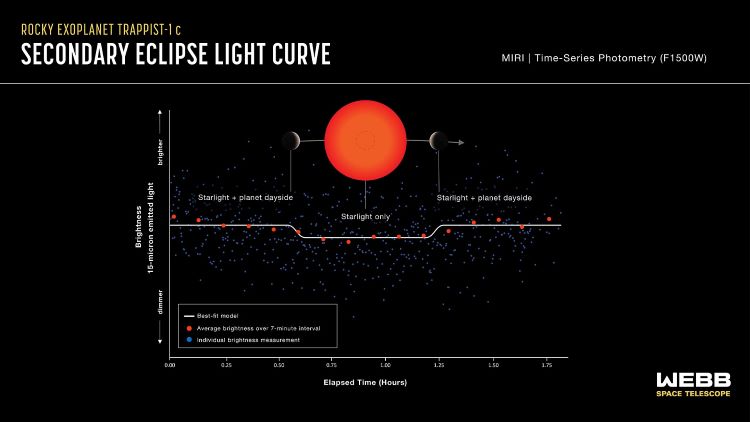A recent study accepted to The Astrophysical Journal uses computer models to investigate why the exoplanet, TRAPPIST-1c, could not possess a thick carbon dioxide (CO2) atmosphere despite it receiving the same amount of solar radiation from its parent star as the planet Venus receives from our Sun, with the latter having a very thick carbon dioxide atmosphere. This study comes after a June 2023 study published in Nature used data from NASA’s James Webb Space Telescope (JWST) to ascertain that TRAPPIST-1c does not possess a carbon dioxide atmosphere. Both studies come as the TRAPPIST-1 system, which is located approximately 41 light-years from Earth and orbits its star in just 2.4 days, has received a lot of attention from the scientific community in the last few years due to the number of confirmed exoplanets within the system and their potential for astrobiology purposes.


“The TRAPPIST-1 system is special because it hosts seven approximately Earth-sized planets that exist in orbital locations interior to, within, and outside of the habitable zone, where liquid water may exist,” Katie Teixeria, who is a Graduate Research Assistant in the Department of Astronomy at The University of Texas at Austin and lead author of the study, tells Universe Today. “Since TRAPPIST-1 is an M dwarf star (unlike the Sun, which is a G type star), we are uncertain whether its planets can retain atmospheres, which is a prerequisite for habitability. By searching for atmospheres in the TRAPPIST-1 system, we get the first clues as to whether M dwarf systems, which make up about 70% of stars in our galaxy, are conducive to life.”
For the study, the researchers used a series of computer models to simulate the evolution of TRAPPIST-1c’s atmosphere, specifically pertaining to how much of the planet’s atmosphere was lost over time from the parent star’s solar radiation, also known as stellar (solar) wind stripping. In the end, the results indicated that TRAPPIST-1c potentially experienced a removal of approximately 16 bars of CO2 gas, which the researchers note is less than the current amount of CO2 on Earth or Venus.
Therefore, the researchers concluded two possible scenarios for explaining the lack of CO2 loss during TRAPPIST-1c’s lifetime: either the planet initially formed with low amounts of volatiles, which often include carbon dioxide, nitrogen, water, and hydrogen, and are found on both Earth and Venus in respective large quantities; or TRAPPIST-1c experienced substantial amounts of stellar wind stripping during its early history.
“The major takeaway from this study is that long-term stellar wind stripping in the TRAPPIST system is not strong enough to remove a large CO2 atmosphere from TRAPPIST-1c, and, therefore, TRAPPIST-1c has likely been carbon-deficient for most of its lifetime,” Teixeria tells Universe Today.
In addition to investigating stellar wind stripping on TRAPPIST-1c, the researchers also used these same computer models to investigate how the other six planets within the TRAPPIST-1 system were affected by stellar wind stripping and if they could keep their atmospheres over long timescales. These planets, which are currently hypothesized to be Earth-sized and rocky worlds, include TRAPPIST-1b, TRAPPIST-1d, TRAPPIST-1e, TRAPPIST-1f, TRAPPIST-1g, and TRAPPIST-1h, with TRAPPIST-1b orbiting inside of TRAPPIST-1c and e, f, and g residing within the star’s HZ.
What makes the TRAPPIST-1 system unique is the extremely compact distances of the planets to each other, as all seven orbit well within the orbit of Mercury, making the investigation into potential stellar wind stripping even more enticing. However, despite their compact orbits, the researchers made an intriguing discovery using their computer models.

Teixeria tells Universe Today, “We predict that the more distant TRAPPIST-1 planets may retain atmospheres because the atmospheric mass-loss due to stellar wind decreases with the square of distance from the star, and the runaway greenhouse effect is unlikely to occur on these distant, colder planets. This means that water and other molecules are likely to stay closer to the surface rather than evaporate away from the planet.”
Going forward, the researchers note that future JWST observations will allow them to gain a better understanding of the makeup and sizes of the atmospheres for all the TRAPPIST-1 planets.
What new discoveries will researchers make about the TRAPPIST-1 system and their planetary atmospheres in the coming years and decades? Only time will tell, and this is why we science!
As always, keep doing science & keep looking up!
The post TRAPPIST-1c Isn’t the Exo-Venus We Were Hoping For. But Don’t Blame the Star appeared first on Universe Today.
from Universe Today https://ift.tt/Z14mtrG
via IFTTT
Comments
Post a Comment